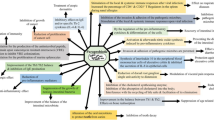Abstract
Previous studies have indicated that borneol has double side effects on the central nervous system (CNS), but the mechanism is unknown. The aim of this study was to clarify the relationship between excitation ratio [contents of excitatory amino acids (AAs) versus that of inhibitory] and the content of natural borneol after a single oral dose. Mice were administered a 1.2 g/kg dose of natural borneol (containing 98% d-borneol) by oral ingestion. Brain samples were collected before administration and at 0.083, 0.167, 0.25, 0.333, 0.5, 0.75, 1, 1.5, 2, 2.5, 3, 4 and 5 h after administration. The brain concentration of natural borneol and contents of AA neurotransmitters in mice brain were determined by GC–MS and HPLC-FLU, respectively. After per oral application, natural borneol was absorbed rapidly into the brain and could be determined 5 min after dosing. The maximal brain concentration (86.52 μg/g) was reached after 1 h post-dosing. Natural borneol could affect the contents of AA neurotransmitters in mice brain: l-aspartic acid increased significantly from 0.083 to 1 h after administration, l-glutamic acid increased significantly at 0.333 h and decreased from 1.5 to 5 h, gamma-amino-N-butyric acid increased significantly from 0.167 to 5 h, whereas glycine was not affected. The excitation ratio is the contents of excitatory AAs versus that of inhibitory AAs, which reflects the excitatory or inhibitory state of the body. The excitation ratio elevated transitorily and then declined 0.5 h post-dosing; there were significant differences between 1.5–5 h post-dose compared with pre-dose. The present study indicated that natural borneol could affect the contents of AA neurotransmitters, and the change in excitatory ratio led to borneol’s double side effects on the CNS.




Similar content being viewed by others
References
Fang YQ, Zou YY, Li L et al (2002) Effects of FXKQY and QTY on CNS excitability. Res Tradit Chin Med 18:40–42
Granger RE, Campbell EL, Johnston GAR (2005) (+)- And (−)-borneol: efficacious positive modulators of GABA action at human recombinant α1β2γ2L GABAA receptors. Biochem Pharm 69:1101–1111
Hu LM, Qu CQ, Li YL et al (2005) Experimental compare of synthetic borneol and d-borneol on PCE micronucleus in mice. Chin Tradit Herbal Drugs 36:571–572
Hu LM, Jiang M, Lin S et al (2006) General reproductive toxicity of natural borneol and synthetic borneol in mice. J Toxicol 20:275–276
Huang WD, Lv WQ (2008) Research progress of borneol. China Pharm 17:64–66
Li WR, Yao LM, Mi SQ et al (2004) Effect of borneol on histamine and 5-HT in rat’s hypothalamus. J Chin Med Mater 27:937–939
Liang MR, Liu QD, Huang TL et al (1993) Pharmacokinetic study of borneol in rat’s serum and brain. Tradit Chin Drug Res Clin Pharmacol 4:38–40
Liu Y, Hu LM, Li YL et al (2004) A comparative study on the mutagenicity of natural borneol and synthetic borneol. Tradit Chin Drug Res Clin Pharmacol 15:232–235
Muhlbauer RC, Lozano A, Palacio S et al (2003) Common herbs, essential oils, and monoterpenes potently mokulate bone metabolism. Bone 32:372–380
Nestler EJ, Hyman SE, Malenka RC (2001) Molecular neuropharmacology: a foundation for clinical neuroscience, 1st edn, vol 142. People’s Medical Publishing House, Beijing, p 154
Park TJ, Park YS, Lee TG et al (2003) Inhibition of acetylcholine-mediated effects by borneol. Biochem Pharm 65:83–90
Xiao YY, Ping QN, Chen ZP (2007) The enhancing effect of synthetical borneol on the absorption of tetramethylpyrazine phosphate in mouse. Int J Pharm 337:74–79
Xu RS (2004) Natural products chemistry, 1st edn. Science Press, Beijing, p 181
Xue L, Chen XW, Fan HX et al (2006) Effect of borneol on levels of monoamine neurotransmitters in prefrontal cortex of rat after long-term continuous operations. Acta Academiae Medicinae Militaris Tertiae 28:1867–1869
Acknowledgments
This project was supported by National Natural Science Foundation of China (grant number: 30701100).
Author information
Authors and Affiliations
Corresponding authors
Rights and permissions
About this article
Cite this article
Li, Wr., Chen, Ry., Yang, L. et al. Pharmacokinetics of natural borneol after oral administration in mice brain and its effect on excitation ratio. Eur J Drug Metab Pharmacokinet 37, 39–44 (2012). https://doi.org/10.1007/s13318-011-0058-5
Received:
Accepted:
Published:
Issue Date:
DOI: https://doi.org/10.1007/s13318-011-0058-5




